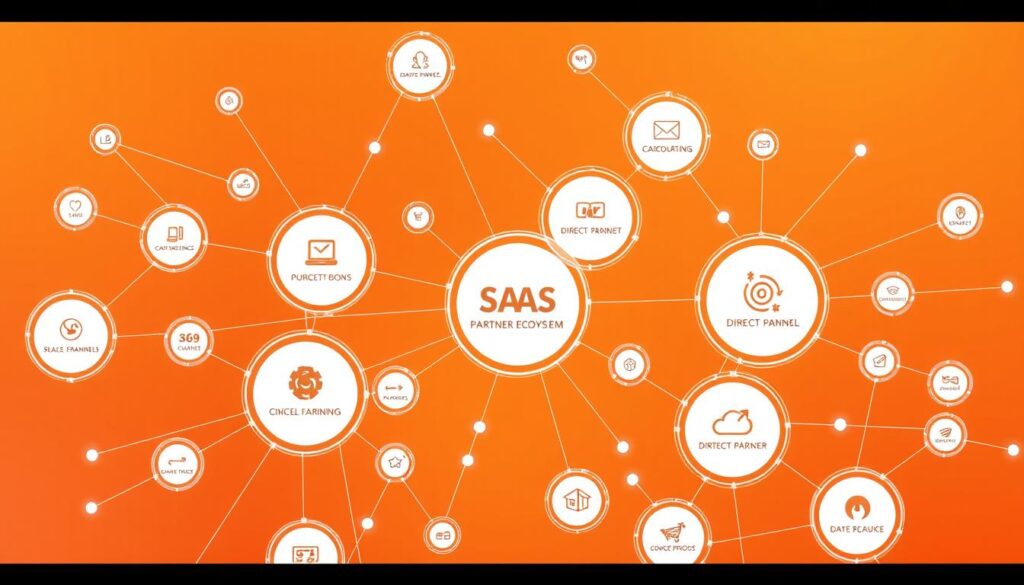The SaaS applications market is expected to grow from $215 billion in 2023 to $278 billion in 2024. This is a 30% increase in just one year. It shows how crucial good go-to-market strategies are in the SaaS world.
Channel partners and direct sales are key to this growth. Big tech companies are using them together to great success. For example, Microsoft gets 95% of its business from partners. Salesforce and Autodesk also get a big chunk of their business from partners, at 70% and 65% respectively.
This change in sales strategies is significant. The old direct sales model is being updated. Now, there are over ten types of channel partnerships, like resellers and system integrators.
This new ecosystem is changing how SaaS companies grow. By working with both channel partners and direct sales, companies can reach new markets faster. They can also launch products quicker and offer solutions that fit each customer’s needs. In fact, companies using channel partnerships can get new products to market 25% faster than those relying only on direct sales.
The partnership between channel partners and direct sales does more than just expand reach. It creates a strong, flexible sales model that can adjust to market changes. As we dive deeper, we’ll see how this approach is changing SaaS growth strategies.
Key Takeaways
- The SaaS market is experiencing rapid growth, projected to reach $278 billion in 2024.
- Leading tech companies attribute 65-95% of their business to partner ecosystems.
- Channel partnerships come in over ten different forms, offering diverse collaboration opportunities.
- Companies using channel partnerships report 25% faster time-to-market for new products.
- The synergy between channel partners and direct sales is reshaping SaaS growth strategies.
The Evolution of SaaS Sales Models

The Software as a Service (SaaS) industry has changed a lot in the last 20 years. This change has updated how companies work with partners, sell through different channels, and use indirect sales.
Era of Foundational Partnerships (2000-2010)
In the early 2000s, SaaS companies mainly sold directly to customers and focused on keeping them. Salesforce was a leader, reaching $1 billion in revenue by the end of the decade. Back then, partnerships were mostly about referrals.
Rise of Integrated Partnerships (2010-2020)
The 2010s brought a new focus on product growth and APIs. This period saw better partnerships. SaaS companies used more channels to reach more customers. The Salesforce AppExchange is a great example, with 91% of customers using at least one app.
Current Era of Diverse Ecosystems (2020-Present)
Now, SaaS companies aim for fast growth through diverse partnerships. The SaaS market is growing fast, expected to hit $278 billion by 2024. By 2024, 73.2% of tech revenue will come from indirect sales through partners.
“Companies that successfully manage strategic partnerships can achieve growth milestones faster and with less time investment than independently.”
This time is marked by cloud marketplaces and AI solutions. For example, CrowdStrike hit $1 billion in sales through AWS Marketplace in 2023. Workday also launched an AI Marketplace to help customers use AI and ML.
Channel Partners vs. Direct Sales: Understanding the Core Differences

The SaaS industry has two main sales methods: channel partners and direct sales teams. Each has its own benefits and drawbacks in reaching markets, building customer relationships, and costs.
Direct sales teams can make more money and control the sales process better. They are great at selling complex tech that needs a lot of support. Companies that choose direct sales keep a tight grip on branding and customer contact, which is key for keeping customers happy and loyal.
Channel partners, however, help expand your market and bring in specialized knowledge. They’re good for fast growth in many areas. Using third-party distributors can cut initial sales costs by up to 30%, which is great for startups or companies with limited funds.
- Direct sales give you full control but need a big investment in marketing and skilled teams.
- Channel partners open up more market access but might cut profit margins by 20-25%.
- Using both direct and channel sales can be the best strategy, combining their strengths.
Good channel management means spending 20-25% of sales efforts on partner relationships. This can boost market reach and customer interaction by 10-30% when you mix direct and channel sales.
“Knowing your competition and their sales models is key; companies with varied sales strategies can grow 15-20% more in revenue.”
Deciding between channel partners and direct sales teams depends on your product, market goals, and resources. Many SaaS companies do well by using both models to grow as much as possible.
The Current State of SaaS Channel Partnerships

The SaaS industry is changing fast, with channel partners becoming more important. This change moves away from old direct sales methods. It’s changing how software is sold and how companies make money.
Market Size and Growth Projections
Channel partners are now a big deal in SaaS sales. Companies that focus on infrastructure saw a 5% rise in channel sales. Both types of SaaS companies saw a 2% increase. This trend is likely to keep growing, with 75% of software sales coming from indirect channels.
Leading Companies’ Partner Attribution Rates
Top SaaS companies are using partner networks a lot. On average, partners bring in 70% of a company’s revenue after they start working together. Companies with strong channel partnerships saw their sales cycles drop by 25% from 2023 to 2024. Those without saw a 10% increase.
Partner Revenue Trends and Forecasts
The future looks good for channel partnerships in SaaS sales. Companies using these networks grow 30% faster than those only using direct sales. Channel revenue starts to grow around $100M in annual revenue. Reseller networks and consulting firms are key in the enterprise world.
“Channel partnerships are not just a sales strategy; they’re a growth accelerator for SaaS companies.”
As the SaaS industry grows, working well with both channel partners and direct sales teams is key. Companies that get this right will have a big advantage in the fast-changing SaaS world.
Building a Strong Partner Ecosystem
A strong partner ecosystem is key to growing a SaaS business. It helps companies reach more customers and add value. Let’s look at what makes a partner ecosystem thrive.
Technology Partners and ISVs
Technology partners and ISVs are essential. They add new features to products. For example, 91% of Salesforce users have installed apps from AppExchange.
This integration boosts the product and cuts down on customer loss. Adding one app or integration can reduce churn by half.
Service Partners and Systems Integrators
Service partners and systems integrators offer specialized skills. They help set up complex solutions and provide custom services. Working with these partners can improve marketing by 30% and reduce sales risk by 25%.
Distribution and Reseller Networks
Distribution channels and reseller networks are crucial for growth. They can increase market reach by 70%. This lets SaaS companies enter new areas or industries easily.
Using reseller networks can grow a customer base by 50%. It gives access to partners’ existing connections.
Creating a strong partner ecosystem needs careful planning and management. Companies that set clear goals for partnerships see a 20% higher success rate. By focusing on these relationships, SaaS businesses can grow and keep customers happy.
Leveraging Cloud Marketplaces for Growth
Cloud marketplaces are changing how SaaS companies sell. They offer a great way to grow, adding to traditional sales methods. The numbers show how big of an impact they have.
Canalys predicts cloud marketplace sales will hit $45 billion by 2025. They could reach $85 billion by 2028. This huge growth comes from buyers’ changing habits and the benefits of these platforms.
SaaS companies using cloud marketplaces see big wins:
- 80% increase in Average Selling Price
- 40% reduction in time to close deals
- 27% boost in win rates
- 280% increase in sales velocity
These platforms make buying easier and reach more customers. For example, AWS Marketplace has over 4,000 sellers. It offers great programs for SaaS partners.
Cloud marketplaces are more than just another way to sell. They’re key to many companies’ sales plans. By 2027, over half of sales will go through partners, showing their importance.
A VP of sales closed a $10 million deal in just 5 minutes through a cloud marketplace. This shows how efficient these platforms are.
For SaaS companies wanting to grow fast, cloud marketplaces are a great chance. They offer more visibility, easier post-sales, and access to big cloud users. As the SaaS world changes, cloud marketplaces are key to good sales strategies.
Partner Program Development and Management
For SaaS companies, managing channels well is key to growing their market. A good partner program can really help with indirect sales and keep customers happy. Let’s look at some strategies for building and managing strong partner relationships.
Partner Recruitment Strategies
Finding the right partners is vital for success. Look for those who share your goals and values. Setting up a formal channel program makes finding partners easier. Choose partners with local knowledge and strong customer ties to improve your reach.
Training and Enablement Programs
It’s important to give partners the tools and knowledge they need. Training should cover:
- Product knowledge
- Sales techniques
- Marketing strategies
Good training helps partners succeed and boosts your channel’s performance. Companies with strong programs see a 30% jump in partner revenue.
Performance Monitoring and Support
It’s crucial to track how well partners are doing. Use KPIs like sales and lead conversion to see how they’re doing. Regular meetings and newsletters keep partners in the loop. Using PRM systems can make things run smoother and more efficiently.
“High-performing Partner Sales Managers can drive a partner revenue growth rate of about 25% annually when leveraging strong partner relationships and support.”
By focusing on these channel management areas, companies can grow more through both direct and indirect sales.
Direct Sales Team Integration with Channel Partners
Integrating direct sales teams with channel partners is a big challenge in SaaS sales. A good strategy combines their strengths. This way, you cover more market and increase revenue. Let’s look at the important parts of this integration.
Defining Clear Roles and Territories
To avoid conflicts, it’s key to set clear boundaries. Give specific areas to each sales channel. This makes sure direct sales teams and partners don’t fight over the same customers. It helps them work together better.
Compensation Models and Incentives
It’s important to have fair pay models. Think about shared commissions or bonuses for teamwork. For example, direct sales teams could get a part of deals made by partners in their area. This encourages them to help partners succeed, not see them as rivals.
Conflict Resolution Strategies
Even with the best plans, problems can still happen. Have clear ways to solve these issues quickly. This could be a team to help with disputes or a formal way to handle them. Keeping in touch regularly can stop many problems before they start.
By focusing on these areas, companies can make a good team of direct sales teams and channel partners. This teamwork leads to better sales strategies and helps SaaS grow.
Measuring Success in Partner vs. Direct Sales
It’s key to check how well channel partners and direct sales work. Companies use special metrics to see who’s doing better.
- Partner-sourced revenue
- Deal registration rates
- Partner activation rate
- Number of enablement sessions
Direct sales gets checked with:
- Sales cycle length
- Win rates
- Average contract value (ACV)
- Customer acquisition cost (CAC)
Companies should look at these numbers side by side. This helps spot what’s working and what’s not in each way.
It’s also important to look at how happy customers are. Partner Net Promoter Score (PNPS) and customer satisfaction scores show how well partners are doing.
“Measuring success in channel partnerships isn’t just about numbers. It’s about understanding how partners contribute to overall growth and customer satisfaction,” says a channel management expert from Affise.
Using these numbers and insights, businesses can make their sales better. They can grow by using both partners and direct sales well.
Future Trends in Channel Partnership Models
The SaaS industry is changing fast, affecting partner ecosystems and sales models. Several trends are set to change how we do channel partnerships and sales.
AI and Automation in Partner Management
Artificial Intelligence is changing how we manage partners. AI is automating almost half of sales tasks, leading to big improvements. It boosts sales accuracy by 30% and sales volume by 10%.
This tech makes onboarding, training, and checking up on partners easier. It makes working together more efficient.
Emerging Partnership Types
New partnership models are changing the game. Ecosystem partnerships, influencer collaborations, and platform alliances are becoming more common. These new types are changing how SaaS companies work with their partner ecosystem and sales strategies.
Predicted Market Evolution
The balance between channel partners and direct sales is shifting. With 70% of B2B sales happening through indirect channels, partners are key. Yet, there’s a move towards team-focused selling, with 40% of B2B groups planning to stop channel marketing soon.
This change means companies need to be quick to adapt. They need agile sales strategies and flexible go-to-market models.
- IT services spending projected to reach $1.5 trillion globally by 2024
- Digital transformation projects expected to hit $3.9 trillion by 2027
- 60% of channel firms report improved business conditions
As the SaaS world keeps changing, companies must stay flexible. By embracing these trends and adjusting their partner ecosystems and sales strategies, SaaS businesses can thrive in this fast-paced market.
Conclusion
The world of SaaS sales has changed a lot. Now, channel partners and direct sales are key to growing. When used together, they lead to the best results. Companies using both see a 10-15% boost in sales.
Creating a strong partner ecosystem is vital for SaaS companies. With 75% of global trade going through third parties, the growth potential is huge. Channel partnerships can expand market reach by 30-50% more than direct sales. At the same time, direct sales keep customers for 15-20% longer.
The future of SaaS sales is about using many sales strategies. Ecosystems are expected to bring in $80 trillion a year by 2030. By mixing channel partners and direct sales, SaaS companies can grow more. They can also make customers happier and stay ahead in a changing market.

